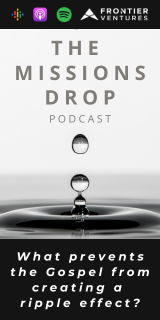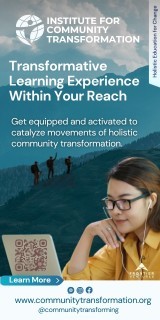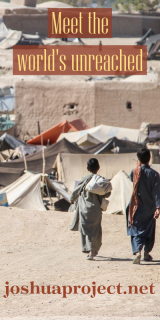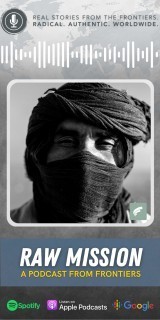Youth With A Mission: “Just Beginning” at 25

This December marks the 25th Anniversary of Youth With A Mission (YWAM pronounced 7warn"). Mission Frontiers thought it would be an appropriate time to take a closer look at YWAM and to introduce our readers to this agency that helped pioneer short term mission opportunities for pregraduate young people.
For many of us at the US. Center for World Mission, our first contort with YWAM came last year while we prepared our campus for the IFMA/EFMA conference (Mission Frontiers, Vol. 6, No. 10 12, p. 30). YWAM assigned over 100 short term workers, most of them from New Zealand, to help clean, paint, weed, plant, type and answer telephones as needed. We were impressed by their generous spirit.
Since that time, several of our peers have left the Center to take one or more of the YWAM training programs the 07'S (Discipleship Training School), for instance, or SOE (School of Evangelism). We have heard Loren Cunningham, YWAM'S International Director, speak on God's guidance; we have heard other YWAMers teach on 'The Father Heart of God." 'Relationships," and "Meekness." And we have heard about YWAM's Pacific & Asia Christian University (PACU ¬pronounced "packyou"), an educational institution that seems to have more than afew ideas in common with our own William Carey International University.
Todd Johnson, son in low of Dr. and Mrs. Winter, founders of the Center, helps lead YWAM's Frontier Peoples Project that has its main office here at the Center. He gives us one more intriguing contact with the organization.
YWAM leaders, despite the size and complexity of their organization, are calling their fiat 25 years 'Just a Beginning," We think that's rather remarkable, Consider.
In its first four years, YWAM sent out about 20 vocational workers, people with specific skills needed for short term responsibilities on the field. It wasn't until June 1964 that the first major outreach of young people occurred. That summer, 146 young people headed for the Carribean.
Today, the organization sends out an average of close to 15,000 young people a year to get their first taste of personal evangelism. In its entire history, YWAM has sent out over I 00,0W young people into all but 20 of the world's 223 U.N. recognized countries, territories and protectorates. YW&M has legally and financially autonomous bases in each of the 59 countries in which it has established permanent ministries, "Just beginning"?
It 1967, YWAM had only 10 full-time staff members including Cunningham and his wife, Darlene, Today, YWAM boasts over 5,000 staff.
"Just beginning"?
In 1967, Cunningham reflected on the Christian training he received during his childhood, 'Darlene and I both had had such incredibly rich childhoods of teaching and example from our parents and grandparents. I thought. Wouldn't it be great to have a school, deliberately designed to be in a family setting, where people could be introduced to the things we had learned and allowed the chance to try them out for themselves?"
Thirty six young people went to Switzerland in 1970 to attend the first YWAM School an SOB (School of Evangelism). Beginning with classroom instruction, the School ended with practical experience. During the summer, students spread out into Germany, Spain, France, Great Britain, Yugoslavia, Bulgaria and Afghanistan, They met people, saw their living conditions, preached the Gospel, and helped wherever they could.Today, YWAM has over a hundred SOE's, DTS's (Discipleship Training Schools), LTS's (Leadership Training Schools), SOM's (Schools of Missions), and other training opportunities in dozens of locations around the world. (See PACU ankle for further details,) 'Just beginning?'
When the SOE students gathered together at the end of their summer experience in 1970. Don Stephens, now bead of YWAM's ship ministry, suggested they should sponsor what seemed like an ideal challenge for short teen workers; a Christian outreach during the 1972 Olympic Games in Munich, Germany. That was the beginning of another new ministry.The 1972 Summer Games witnessed the first of what has become a major YWAM emphasis; large scale evangelistic campaigns at sporting events. Twelve hundred young people went to Munich with YWAM. Eight thousand were present in Montreal in 1976. Two thousand went into the Soviet Union in 1980. Eleven thousand were present in Los Angeles last year. Hundreds of young people go with YWAM to each of the World Cup Soccer matches.
The 11,000 young people who came to Los Angeles last year were from 77 countries, 3,600 churches, and 73 different denominations. Over 3,000 of them were from outside the United States. "Just beginning"?
During the first YWAM outreach in the Bahamas in 1964, Hurricane Ceo hit the Caribbean. A hundred and thirty eight people were killed, hundreds more injured, and thousands were left without homes. As be pondered the awful weight of these losses, Cunningham says, 'an idea began to lake shape in my mind. If we could go in with food, clothing, building supplies we could even have our fellows help rebuild homes. But to handle so many people, so many tons of supplies, we'd need a ship.'
Well, YWAM got a ship all right. Infact it got two. The first, an old 11,000 ton passenger liner, was purchased in late 1978. Today, the Anastasis (Greek for Resurrection) and Good Samaritan are being used within the broader Mercy Ministries program of YWAM to bring goods, medical assistance, and skilled construction.
Youth With A Mission's Pacific and Asia Christian University (PACU pronounced "pack you"), headquartered next to YWAM's International Headquarters in Icona, Hawaii, is a missionary preparation school designed to equip students for spiritual warfare on the front lines of tsr ions. No ivorytower acadeniso community, PAW seeks to involve students in intense practical experiences with every class they take. Either in immediate conjunction with his class lectures and book studies, or immediately fotlowinp the academic portion of the class, every student in virtually every class on every subject is required to put his conceptual knowledge to practical use.
PACU administrators call it a "modular" approach. 'Most of our classes are set up with three months of intensive classroom Instruction follow,c by two or three months of outreach or other practical experience related to the course content Some classes are longer, but they are all set up with the theoretical and practical tightly interwoven,' says Dr. Howard Malrnstadt, provost and senior vim president of the university.
Another feature of education at PACU is its international flavor. Not only doworkers to needy areas of the world, YWAM Mercy Ministries include supervision and administration of camps serving over 200,000 refugees in East Asia, One of their camps houses 68,000 displaced persons.
YWAMers oversee the production or provision of food, clothing, shelter, preschool training, medical and other services to tens of thousands of refugees. A sewing project involving 1,900 refugees provides clothing for 30,000 people. In another area, refugees am being employed to make sandals from old tiles. Ten thousand people are being fed in one camp. A thousand children are receiving basic education in another. In facts YWAM is the largest relief agency working in Thailand. And best of all, the services are offered in the name of the Lord Jesus Christ "Just beginning"?
It was June 1956. Having just finished his second year at Bible school, Loren Cunningham was in the Bahamas with a few friends on an evangelistic singing tour. One evening he returned to the guest room where he was staying when, he says: 'A picture began to nm through mymind. Isawaworld map. I could see all the continents. Waves were crashing onto their shores. Each went onto a continent, then receded, din came up further until the continents were completely covered.
'As I watched, the scene changed. The waves became young people. They were my own age and even younger. They were talking to people on street corners and outside bars. They were going from house to house. They were preaching. Everywhere they went they were caring for people, helping the lonely and the hungry.
"Suddenly the scene was gone. What could that be? I wondered. Then remembered an experience I had had as a 13 year old, when one day in church the words of Jesus had spoken very directly to me: Go into all the world and preach the good news to all creation. That was the vision. Young people fulfilling the Great Commission of Mark 16:15.
"An idea began to grow: God wanted to release the resources of youth for lay missions?'
Cunningham pursued that vision and four years later, in December 1960, Youth With A Mission was born, Originally envisioned merely as an organization that could 'recruit young people from high school and send them out immediately so that later, even going to a university would have a new and deeper purpose," YWAM today is, according to Curmingharn, "committed to fulfilling the Great Commission by influencing each of The Sewn Mind Molders of society: church, family, school, media, government, economics, and the art and entertainment industries."
Perhaps that explains the diversity of ministries within the organization, the emphasis not only on training and evangelism, but relief and development as well. It may also explain why, even in affluent countries, even where tens of thousands of people are not facing imminent starvation or execution at the hands of hostile armies. YWAM offices have very few 'typical' programs. Beyond DTS's and SOWs, basic ingredients of virtually every YWAM ministry, there really is no such thing as a typical YWAM program.
For instance, Floyd McClung, director of YWAM's EuropefMid Jiast'Africa regional office in Arnsterdan Holland, helps oversee production and distribution of the most popular hynmal in the French language, conferences, management of major Christian bookstores, sponsorship of large evangelistic meetings, production and distribution of praise albums and lapel (in English and Dutch), sending of long range church-planting teams to East Africa, sponsorship of Sunday evening services in communities throughout Holland (leading a renewal movement in the Dutch church) — sponsorship of Christian concerts, coffeehouse ministries, a ministry to punk rockers (including a punk rock night club on the river).
There's more, but you get the general feel! McClung happens to be YWAMs Prophet to the City. He is the one who is generally recognized as the leader and model, the one who is agitating and pulling YWAM along to get involved in ministry to the city.
Kalafi Moala, YWAIvIs Pacific and Asia director, is the organizations 'Prophet to the Unreached Peoples.' He is intent upon outlining missionaries for long term work among Hindus, Buddhists
and Muslims in India, Nepal, Pakistan, Bangladesh, Indonesia, Malaysia, Mongolia, Tibet ¬wherever they may be found. By 1990, he says, he expects "75 percent of all our outreaches will be oriented to Hidden Peoples."
But our question remains: With the size, diversity, activity, and strength of the organization, why do YWAM leaders speak of themselves as "just beginning!'?
Does it have to do with their call to service?
We've mentioned their help to the Center last year in preparation for the IFMAJEFMA conference. This fall Loren Cunningham wrote a letter to all their international leaders asking for their full cooperation in supporting the Center's Walk for the Hidden Peoples.
That kind of selflessness is not new with the organization.
YWAM had a ship picked out for their Mercy Ministries way back in 1973; in fact, they made a $7ZOO deposit on it. But then one day, only a few weeks before the final payment was due, Cunningham read Hebrews 12:26 and 27: "Yet once more I shake not the earth only, but also heaven ...that those things which cannot be shaken may remain." He wondered if the Lord might be speaking about the ship.
He was. Within a matter of hours, what had been a six month torrent of money flowing in toward the purchase of the Maori was shut off completely. Says Cunningham. "Not one mote item was pledged, not one additional worker or service was released. And this all happened even though there was no way for people to have known of any change. Suddenly the flow had been turned off and only God could have done it.
The death of the Moon dream was a time of testing for YWAM. Says Cunningham, "We found we had subtly turned from the Giver to the gift We had become so concerned about the purchase of the ship that we had shunted Jesus off to the side. We were cheering a ship and forgetting Jesus!"
During a week long meeting.
YWAM's international leaders were brought to see what Cunningham calls their 'great corporate shortcomings.'
"To our honor we saw that we'd begun to think that Youth With A Mission was God's 'favorite tool' we were the 'most spiritual'; we had learned more about faith; we had a corner on 'releases.' We looked down into our hearts and what we saw there was disgusting."
The outcome of this appraisal was repentance and a new orientation to service. YWAMers don't mention the incident, but members of Operation Mobilization (OM), another short term mission agency, recall with gratitude and a certain amount of awe a special act of generosity on the part of YWAM. Soon after the death of their Moon dream, YWAM contributed well over $100,000 toward the purchase of OM second ship, the DouIos.
That kind of service is almost a YWAM trademark. The story is told of YWAM's introduction to refugee camps. In 1978, Cunningham went to southeast Asia to see what YWAM could do. 'The first refugee camp we visited was in Hong Kong. No magazine articles could prepare eyes and ears or nose 16r the shock of that scene in Camp Jubilee.
"The smell came first, the brown stench of raw human waste hit us before we entered the place¬As we walked in the main entrance, into an inner passageway, we found the source. The lower floor of the building was eight inches deep in human waste.
'We picked our way around the perimeter as best we could, camp officials pointing to some broken sewer pipes along the side of the wail. There was not enough money to hire a plumber from the city, and no one there was qualified or willing to tackle the huge mess.'
Within weeks, a group of 30 YWAMers had entered Camp Jubilee and begun to do what no one else had been willing to do. They shoveled out the human waste, repaired the pipes, and fixed the toilets.
The stories could be multiplied.
Perhaps YWAM leaders call their first 25 years 'just a beginning' because they hope to see this kind of service increase. If so we can only, applaud their efforts.
Or perhaps this feeling of 'just beginning" comes from YWAM's goals and objectives.
When Cunningham first founded YWAM in 1960, he envisioned the day when the organization would have 1,000 young people in the field at one time. That goal was reached in 1972 at the Munich Olympics. Today YWAMers are dreaming of 50,000 young people on the field at one time.
Arid then there's the matter of YWAM staff. Full time staff has increased at a remarkable rate in the last several years (this year done they registered an incredible 19 patent gain from 4,200 to 5,000+ personnel). But the percentage of short tamers sticking with the organization has been something less than awe inspiring. Obviously, with over 100,000 young people sent out, and a total staff of just ova 5,000, them has been significant attrition between shortterm service with the organization and long term commitment to YWAM.
Moala says YWAM hopes soon to retain 25 percent of its short termers for longterm service.
But those are only surface goals.
Moala and other forward looking leaders in YWAM are beginning to speak of goals and objectives in other areas as well.
For instance, there is "Project 223,' a program that is currently being developed for use throughout YWAM, Until very recently indeed, even until tcday YWAM has been surprisingly un selfconscious. When one asks about specific achievements of YWAM ("How many churches does YWAM plant in a year?' or 'How many students will graduate from Pacific & Asia Christian University? PACU, YWAMs training school, see box), it is difficult to find answers. When I asked these and other questions of persons I thought should know, I was told, 'Oh, you'll have to talk with someone else on that subject" All right, thought I guess I was just mistaken about who should know what. But then when 1 got to the person to whom I was referred, he didn't know the answer either. Part of the reason for this lack of information is, as one leader put it, that YWAM has been 'more concerned to do the work than to talk about it," But at the same time, the tack of hard data makes it difficult for YWAMers to evaluate what they are doing. They have few solid grounds on which to plan improvement. How can you plan improvement when you have no measurement of what you look like today?
Well. Project 223 deals with these problems of insufficient information, poorly defined goals, and an inability to evaluate work in progress. The Project is designed to help YWAM achieve longerrange mission objectives through mission research. it seeks to clarify the goals, define the means, and evaluate the activities of YWAMis diverse ministries.
If Project 223 leaders dreams are fulfilled, YWAM will be able to speak with confidence about its work. It will know where it has come from and where it is going. But thither, YWAM leaders will be able to evaluate their progress according to a definite plan.
Said one outside consultant to the Project, "Loren told them (the Project 223 leaders) that, during the 25th Anniversary celebration coming up in
Hawaii this December, they should do everything possible to convince the YWAM leaders of the need for the facts, the usefulness of the facts, and the feasibility of gathering them. Project 223 has to come into its own."
Moala downplays some of the stress on research and fact gathering in deference to the ultimate goals Project 223 hopes to serve. Project 223 is not so much research as it is trailblazing: opening a trail for others to follow. We trailbiaze with a view to planting a long term ministry. We want to establish contacts, find out about opportunities for service, and engage in intercessory prayer and spiritual warfare. Our purpose always is to establish a beachhead for future settlement."
Certainly, if one reads the Project Handbook, one can see what he has in mind. The Handbook defines the following three goals for YWAM International:
- To establish a vital work in eves)' country of the world (223);
- To establish permanent outreaches in every world class city (130 such cities already identified);
- To engage in effective evangelism among Unreached Peoples in every country of the world.
Those are mighty big goals! And if it is in contemplation of these massive undertakings that YWAMs leaders say they are 'just beginning," we at the USCWM want to take our hats off to them. They have quite a vision, and have much to look forward to. But if their first 25 years are any indication of what will happen in the future, we are confident that, by God's grace, YWAMen will achieve what they set out to do. We certainly pray they will succeed!







comments